
I waited by the runway at Edwards AFB for NASA's Boeing NB-52B Stratofortress to take off with the X-38 Crew Return Vehicle for a couple of hours on the morning of Tuesday, July 10, 2001.
There had been a power failure at NASA Dryden that shut down the systems of the control room just before the scheduled take-off. The take-off was postponed from 8:00 to 10:00. On the scanner I heard the ATIS call out the air temperature as 77 degrees when we first arrived. The desert heated up considerably in the two hours that we waited.
White Northrop T-38A Talons from the test pilot school were flying in the pattern for runway 22 and shooting touch-and-go landings. The red, white, and blue VISTA (Variable In-Flight Stability Test Airplane) Lockheed-Martin F-16 Fighting Falcon took off and departed to the north. Several orange-tailed F-16s of the 412th Test Wing taxied out and took off. Some of them joined the Talons in the pattern.
In the distance we could see dust rising from the lakebed where they were running up the engine of the Lockheed-Martin X-35B joint Strike Fighter.
After a while, the VISTA F-16 returned and shot a long series of low approaches and touch-and-go landings.
We could see smoke rising over the silver and yellow tail of the NB-52B as Gordon Fullerton started up the eight J57 turbojets. Everybody on the radio was reporting that the computer systems in the control room were functioning properly.
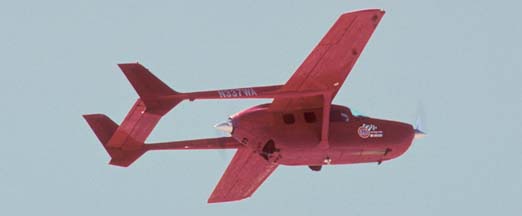 The Wolfe Air Cessna 337, N337WA
low speed chase plane with stabilized television took off from
runway 22.
The Wolfe Air Cessna 337, N337WA
low speed chase plane with stabilized television took off from
runway 22.
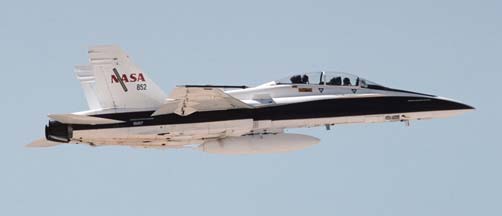 A white and blue NASA Hornet chase
plane lined up with the runway and accelerated toward us. There
was only one Hornet, because the other NASA chase plane was down
for service. An Air Force F-16B was enlisted to serve as the
second chase plane. It was already in the air.
A white and blue NASA Hornet chase
plane lined up with the runway and accelerated toward us. There
was only one Hornet, because the other NASA chase plane was down
for service. An Air Force F-16B was enlisted to serve as the
second chase plane. It was already in the air.
The Hornet circled around and lined up parallel with the runway, aimed directly at us at low altitude. A cloud of black smoke billowed from the NB-52B as Gordon Fullerton turned on the water injection.
 The high pitched scream of the
engines of the NB-52B grew louder as it approached with steadily
increasing speed.
The high pitched scream of the
engines of the NB-52B grew louder as it approached with steadily
increasing speed.
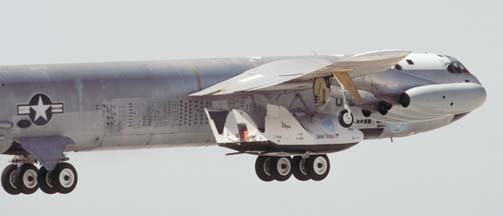 The NB-52B lifted off the runway as
it passed our location.
The NB-52B lifted off the runway as
it passed our location.
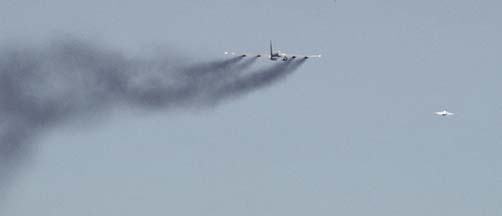 The Hornet pulled into position off
the right wing of the NB-52B as they turned to the north and
climbed to the launch altitude of 37,500 feet.
The Hornet pulled into position off
the right wing of the NB-52B as they turned to the north and
climbed to the launch altitude of 37,500 feet.
We packed our things back into the van for the ride back to Dryden. As usual, the van stopped when we got to the pavement for people to remove bits of gravel from the tire treads so the gravel wouldn't become FOD.
The X-35B was parked on the ramp with its lift jet and lift fan doors open as we drove back up the flightline to Dryden.
The monitor in the Public Affairs Office lobby showed the TV transmissions from the NB-52B and the Hornet chase plane. One of the people from the PAO surfed through the channels, switching between several other TV cameras located around the base. Some of the cameras just showed flightline activity, while a number of powerful telephoto cameras followed the X-38 mission airplanes.
The pilots and launch panel operator were calling out the time to the "cold pass". They were conducting a rehearsal of the launch. Outside I could see the white trail from the smoke generator in the number-2 engine nacelle of the NB-52B approaching from the east. All critical systems performed properly for the cold pass. The NB-52B and its chase planes turned right for another lap around the racetrack pattern. It would take a half hour to fly the lap and launch the X-38.
I stepped outside with my scanner and camera to look at the actual airplanes overhead. I leaned back against the railing around the front porch and braced my foot against the railing on the other side of the wheelchair ramp to steady myself as I aimed my telephoto nearly directly up at the tip of the smoke trail. Through the camera I could make out the shape of the NB-52B and the bright white spot of the Hornet chase plane against the blue-white glare of the summer sky over the Mojave Desert. The shapes became more distinct through the haze as the airplanes got closer to the launch point.
The voice on the radio called down the time to launch. I kept the NB-52B with the X-38 centered in the viewfinder of my camera.
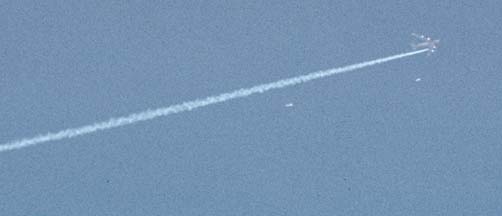 When the voice on the radio called
out "Launch, launch, launch!" I fired off a couple of
quick frames to capture the X-38 falling away from the
Stratofortress.
When the voice on the radio called
out "Launch, launch, launch!" I fired off a couple of
quick frames to capture the X-38 falling away from the
Stratofortress.
The X-38 was a barely visible dot as it glided for nearly a minute. It was easier to track the Hornet chase plane flying alongside.
The two dots separated quickly when the X-38 deployed its 80-foot diameter drogue chute. The dark drogue chute was easy to follow as it descended vertically. After several seconds the distance between the X-38 and its drogue chute increased suddenly, and the giant parafoil appeared between them.
 The parafoil took form and extended itself to
full span in stages. It descended more quickly than the drogue
chute, now relieved of the weight of the X-38. The drogue chute
drifted into the distance.
The parafoil took form and extended itself to
full span in stages. It descended more quickly than the drogue
chute, now relieved of the weight of the X-38. The drogue chute
drifted into the distance.
The voice on the radio called out the altitude of the X-38 in one thousand foot increments. Eventually the parafoil descended from view behind the main NASA Dryden hangar.
I searched out the NB-52B in the sky to the northwest, snapped a last picture, and went inside to watch the rest of the descent on the monitor.
After the landing, the voices on the radio reported that there hadn't been any "deltas" during the descent. Everything had proceeded according to the flight plan.
Link to the NASA Dryden press release about the X-38 parachute test on July 10.
 Boeing NB-52B
Stratofortress Mothership.
Boeing NB-52B
Stratofortress Mothership.
Link to the NASA Dryden X-38 Space Station Crew Return Vehicle photo gallery.
Link to the NASA Dryden X-38 Crew Return Vehicle Project Page.
Link to the NASA Dryden X-38 Crew Return Vehicle Fact Sheet.
Link to the NASA Dryden X-38 Actuator Control Test Project Page.
Link to the NASA Human Spaceflight X-38 Crew Return Vehicle page.
eBook edition of Balls Eight: History of the Boeing NB-52B Stratofortress Mothership |
||
|
My book Balls Eight: History of the Boeing NB-52B Stratofortress Mothership is now available as an eBook for just $10.99, a considerably reduced price compared to the print edition. It has been asserted that the Boeing NB-52B Stratofortress, carrying Air Force serial 52-0008, can lay claim to being the airplane that has seen and participated in more history than any other single airplane. For forty-five years, the NB-52B was a fixture at Edwards Air Force Base. While the NB-52B is most famous for launching the three North American X-15 rocket planes, it continued to serve in the role of launch platform for a multitude of programs until its final mission, launching the Mach-10 X-43A Hyper-X, on November 16, 2004. It was the oldest flying B-52 by nearly ten years. The eBook edition is profusely illustrated with vintage photographs and diagrams and has more pictures than the print edition. It can be dowloaded directly from Lulu.com. It will soon be available from Apple iBookstore, Amazon, Barnes & Noble, and Kobo. | ||
|
Balls Eight: History of the Boeing NB-52B Stratofortress Mothership |
||
It has been asserted that the Boeing NB-52B Stratofortress, carrying Air Force serial 52-0008, can lay claim to being the airplane that has seen and participated in more history than any other single airplane. For forty-five years, the NB-52B was a fixture at Edwards Air Force Base. While the NB-52B is most famous for launching the three North American X-15 rocket planes, it continued to serve in the role of launch platform for a multitude of programs until its final mission on November 16, 2004. It was the oldest flying B-52 by nearly ten years.The NB-52B launched the three X-15 hypersonic rocket planes.
It launched the Northrop HL-10, Northrop M2-F2/F3, Martin Marietta X-24A and Martin Marietta X-24B lifting bodies.
It simulated the steep, power off approach to landing used by the Space Shuttles.
It assisted in the collection of data about wake turbulence from large aircraft.
It served as an air-to-air gunnery target.
It launched 3/8-scale F-15 Remotely Piloted Research Vehicles (RPRV) and Spin Research Vehicles (SRV).
It launched a Ryan Firebee II drone and the Ryan Firebee based Drones for Aeroelastic Structures Testing (DAST).
It launched the Highly Maneuverable Aircraft Technology (HiMAT) RPRVs.
It dropped the 48,000-pound Space Shuttle Reusable Booster Drop Test Vehicle (SRB/DTV).
It released a simulated F-111 crew module from its bomb bay to evaluate new parachute recovery systems.
It was the first airplane to launch a satellite into orbit on the Orbital Sciences Pegasus booster.
It tested the drag chute used to decelerate space shuttle orbiters.
It tested pollution reducing fuel additives with a pair of jet engines mounted under its bomb bay.
It launched the X-38 Space Station Crew Return Vehicles.
It launched the X-43A Hyper-X Supersonic Combustion Ramjets.
The book is 200 pages long. It contains 246 color photographs, 89 black and white photographs, and 2 other illustrations.
You can preview the first several pages of the book.
Books are printed on demand by Lulu.com. When you order one, it is placed in your Lulu.com shopping cart. Lulu.com prints, packages, and ships the book direct to you.

Put a copy of the softcover edition of Balls Eight: History of the Boeing NB-52B Stratofortress Mothership in your Lulu.com shopping cart for $74.95.

Put a copy of the hardcover edition of Balls Eight: History of the Boeing NB-52B Stratofortress Mothership in your Lulu.com shopping cart for $79.95.
Revell has re-released Monogram's 1/72-scale Boeing NB-52B Stratofortress with X-15A-2 kit. You need this book to help you establish the appropriate paint scheme for any particular NB-52B mission that you want to model.
The book is 96 pages long.
You can preview the first several pages of the book.
Books are printed on demand by Lulu.com. When you order one, it is placed in your Lulu.com shopping cart. Lulu.com prints, packages, and ships the book direct to you.
 Put a copy of the softcover edition of Painting Guide for the Boeing Stratofortress Motherships in your Lulu.com shopping cart for $44.95.
Put a copy of the softcover edition of Painting Guide for the Boeing Stratofortress Motherships in your Lulu.com shopping cart for $44.95.
You can buy a 2020 calendar featuring photographs of the Boeing NB-52B Stratofortress Mothership that launched the X-15s in the 1960s and continued launching research vehicles until 2004.
It has been asserted that the Boeing NB-52B Stratofortress, carrying Air Force serial 52-0008, can lay claim to being the airplane that has seen and participated in more history than any other single airplane. This calendar features a dozen pictures of the NB-52B carrying some of the research vehicles that it launched over the years. Photo sources: Air Force, NASA, Richard Lockett, Brian Lockett:
North American X-15-1, 1960
North American X-15-3, 1963
North American X-15A-2, 1967
Northrop HL-10, 1969
Martin-Mariettta X-24A, 1970
Northrop M2-F3, 1972
Martin-Mariettta X-24B, 1973
Orbital Sciences Pegasus, 1989
Supersonic Supercruise, 1995
X-38 V-131R, 2000
X-43A Hyper-X, 2004
 Put a copy of the Balls Eight: Boeing NB-52B Stratofortress Mothership: 2020 calendar in your Lulu.com shopping cart for $14.95.
Put a copy of the Balls Eight: Boeing NB-52B Stratofortress Mothership: 2020 calendar in your Lulu.com shopping cart for $14.95.
 Books about
Edwards Air Force Base and the X-planes available from
Books about
Edwards Air Force Base and the X-planes available from 
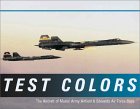 Test Colors: The Aircraft of Muroc Army Airfield
and Edwards Air Force Base by Rene Francillon
Test Colors: The Aircraft of Muroc Army Airfield
and Edwards Air Force Base by Rene Francillon
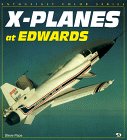 X-Planes at Edwards (Enthusiast Color
Series) by
Steve Pace
X-Planes at Edwards (Enthusiast Color
Series) by
Steve Pace
 Edwards Air Force Base : Open House at the USAF
Flight Test Center 1957-1966 : A Photo Chronicle of
Aircraft Displayed (Schiffer Military History) by Robert D. Archer
Edwards Air Force Base : Open House at the USAF
Flight Test Center 1957-1966 : A Photo Chronicle of
Aircraft Displayed (Schiffer Military History) by Robert D. Archer
 The X-Planes: X-1 to X-45: 3rd Edition
by Jay Miller
The X-Planes: X-1 to X-45: 3rd Edition
by Jay Miller
Send a message to Brian
Go to home page of the Goleta Air and Space Museum.